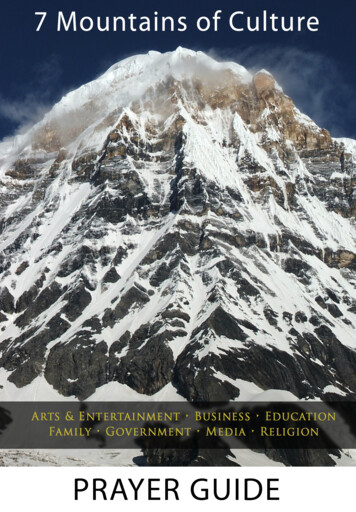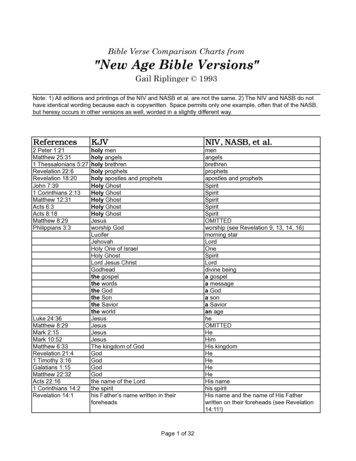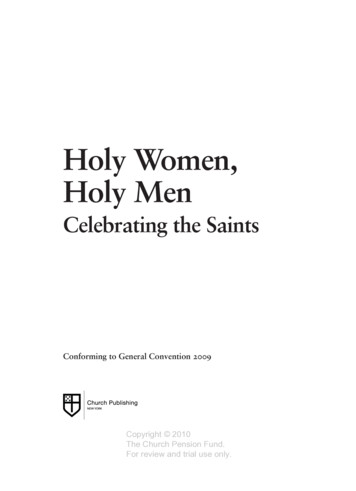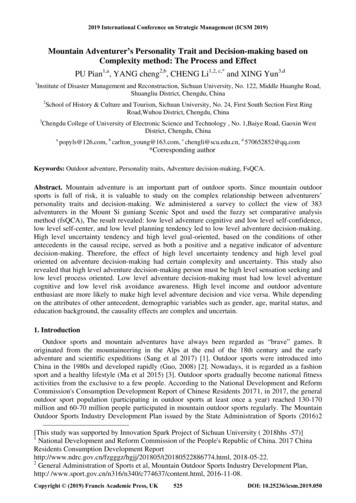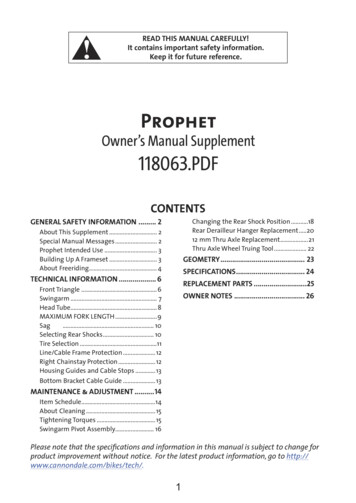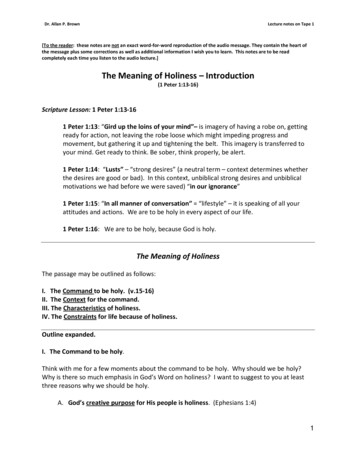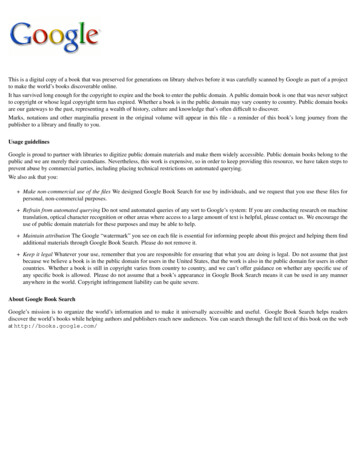
Transcription
This is a digital copy of a book that was preserved for generations on library shelves before it was carefully scanned by Google as part of a projectto make the world’s books discoverable online.It has survived long enough for the copyright to expire and the book to enter the public domain. A public domain book is one that was never subjectto copyright or whose legal copyright term has expired. Whether a book is in the public domain may vary country to country. Public domain booksare our gateways to the past, representing a wealth of history, culture and knowledge that’s often difficult to discover.Marks, notations and other marginalia present in the original volume will appear in this file - a reminder of this book’s long journey from thepublisher to a library and finally to you.Usage guidelinesGoogle is proud to partner with libraries to digitize public domain materials and make them widely accessible. Public domain books belong to thepublic and we are merely their custodians. Nevertheless, this work is expensive, so in order to keep providing this resource, we have taken steps toprevent abuse by commercial parties, including placing technical restrictions on automated querying.We also ask that you: Make non-commercial use of the files We designed Google Book Search for use by individuals, and we request that you use these files forpersonal, non-commercial purposes. Refrain from automated querying Do not send automated queries of any sort to Google’s system: If you are conducting research on machinetranslation, optical character recognition or other areas where access to a large amount of text is helpful, please contact us. We encourage theuse of public domain materials for these purposes and may be able to help. Maintain attribution The Google “watermark” you see on each file is essential for informing people about this project and helping them findadditional materials through Google Book Search. Please do not remove it. Keep it legal Whatever your use, remember that you are responsible for ensuring that what you are doing is legal. Do not assume that justbecause we believe a book is in the public domain for users in the United States, that the work is also in the public domain for users in othercountries. Whether a book is still in copyright varies from country to country, and we can’t offer guidance on whether any specific use ofany specific book is allowed. Please do not assume that a book’s appearance in Google Book Search means it can be used in any manneranywhere in the world. Copyright infringement liability can be quite severe.About Google Book SearchGoogle’s mission is to organize the world’s information and to make it universally accessible and useful. Google Book Search helps readersdiscover the world’s books while helping authors and publishers reach new audiences. You can search through the full text of this book on the webat http://books.google.com/
r .‘ .‘,\a ma,uQM JOUNAI“Y7'-.‘'7I.s: ‘v1)"@- , :OEJFHE\AR. *Eggm, "‘‘‘MLi7‘ ‘.lNU‘ 4 70"",1 3I"1“M . ,b%. \'\q“‘1‘ a, stir he of mefi, it may;\‘f it"?you 9mm, »‘‘ANDj'somi'iff a 4'VL‘ ' '-'9, “ le B'I‘Mzm‘, DUBLIN; Am) mmnt. ‘.,3gfi,11--\I.‘ 1833'‘‘‘ '2.)‘., - '(Prime. 18”“.g ‘1 in‘\ rH ‘v:p F's} od-flr‘53 Q.4, ,.rr'v‘V“ \W '\‘\-\ ,\‘K
THE HOLY MOUNTAINOFLA SALETTE:APILGRIMAGE OF THE YEAR 1854.BY THE 'RIGHT REV. BISHOP ULLATHORNE. “If this counsel or this work be 01 men, it will come tonought: but if it be of God, you cannot overthrow it: lastperhaps you be found eycn to fight againstGod.”—Acts v. 38, 39.F0 URTH EDITION.LONDON:RICHARDSON AND SON, 147. STRAND;9, CAPEL STREET, DUBLIN ; AND DERBY.MDCCCLV.I
INTRODUCTION.In the month of May, 1854, the writer ofthis book left England in company with threefriends to visit the Holy Mountain of LaSalette. Though impressed already with allI had read or heard of an event, which hadproved the source of conversion or of consolation to so many thousands of Catholics, Iresolved to take no further impressions frombooks written on the subject, as an immediatepreparation. By the Divine Mercy, I received consolations on that mountain whichdeepened the interest I had already taken inits mystery. I had the best opportunity ofconversing with most of those persons who fromthe beginning, have been concerned with thesubject, its history, and its investigation; andespecially with those whose names are most before'the public, or who have had the care anddirection of the Children. I had interviews withthe Children of the Apparition themselves.And, in the course of my enquiries, I more thanonce suspended my judgment, and cautiously
4INTRODUCTION.revised the grounds of my conclusions. Ispoke with able men who held variousdegrees of doubt, as well as with earnest believers. And for this purpose I had peculiarfacilities afforded me. And ever since I leftthe Holy Mountain I have felt a strong desireurging me to impart to the Catholics ofEngland more detailed information than theypossess of this remarkable event of our times,-—remarkable, if we do no more than considerthe great spiritual results which have flowedfrom it. Mr. Northcote’s pamphlet has donesomething, but it is little more than an introduction to a subject, at that time scarcelyknown in England beyond a few vague reports.My duties will not allow me time to draw outas full a statement, or to argue it as completely, as I could wish to do. But I will dosomething towards it. And for more ampleinformation I must refer my readers to theable works already published in France. Ofthese books I have made considerable use.The Abbé Rousselot, Canon of Grenoble,and for forty years professor of Moral Theologyin the ecclesiastical seminary of that Dickese,a member of the commission appointed toinvestigate the question of the Apparition, andits historian, has written three works on thesubject, and each of them is sealed with thew!
INTRODUCTION.5formal approbation of the Bishop of theDiocese. Those works are full of documents.The first which appeared, La Verité mr L'Evénement de La Salette, was published in1846. The second, Nou'veaux Documents surL'Evéncment de La Salette, appeared in 1850.The third, entitled, Un Nou'ueau Sanctuaire 12Marie, ou Conclusion cle L’Afaire de La Salette,was published in 1853. They were precededby the Pélérinage 12 La Salette, ou examencritique de Z’Apparition de la Saints V-iérge& deua; bergers, by the Abbé Bez, published inMay 1847. And by the Nonveaux Recits deL’Apparition de la Saints Viérge sur les Montagnes des Alpea, by the Bishop of Rochelle.In this work, the venerable prelate, withoutdeciding as bishop, relates his journey to LaSalette, and intimates his personal convictions.In 1852 a beautiful work appeared, written byMlle. Brulais, of Nantes, who records her owncure of a complication of diseases at La Salette.It is entitled L'Eclw de la Sainte Montagne,ris/ité par la Mére de Dieu, an un Moi: deséjour dans la société des petits bet-yer; de LaSalette. This work was revised by the Archpriest of Corps. It contains a. minute andaccurate delineation of the characters of thetwo children, and records a number of conversations with them, in which the authoress
6mrnonucrron.was either the witness or the interlocutor.It breathes the very aroma of La Salette.There is also a. little work by the AbbéGobert, of Calais, which is not consideredquite so accurate in its details. It is entitledUn Pélérinaye (2 La Salem.
THE HOLY MOUNTAINOILA SALETTE., CHAPTER I.FROM LYONS TO CORPS.DEPARTTNG from Lyons, city of early martyrs,'and centre of the great missionary work 0tmodern days, our pilgrimage more properlybegins.Not, indeed, with the discomfortsof the ancient foot-sore pilgrim, but that therewe left behind us for a time, railroads, correspondence, newspapers, and other mundanedistractions of the kind, and felt grateful forthat comparative isolation which yielded aprecious quiet for disposing and preparing themind. Some forty miles or more bring us toVoreppe.Here the pilgrim must turn aside to theGrand Chartreuse, if but to withdraw himselffurther from the world, and to deepen thedevotion of his heart. Nor is this alien fromthe pilgrim’s one object; for the Children ofthe Apparition have made retreats under thedirection of the fathers of the great monastery;and valuable information on La Salette maybe gathered in these lofty solitudes. As wetake the first ascent, every one we meet points
8run HOLY MOUNTAIN orhis finger to one high peak on the right,covered from its base, as well as crowned, withforest. And on every one's tongue is thename of the eloquent Lacordaire. On thathigh point is a tall cross, scarcely visible, itlooks so thin in the blue and bright sky. Itmarks the spot behind which that reviver ofthe French Dominicans has placed his brethren,who, in that lonely retirement, are preparingthemselves for their spiritual combats with theworld.The road for ten miles runs through avalley flanked with wooded mountains, andpresenting many points of remarkable beauty.At St. Laurent du Pont mules are in requisition, and at a mile beyond, the huge mountains begin to close upon the stream of theGuiers Mort, and the ascent begins in earnest.\Ve reach the point of the old timber-builtiron-forge, well known to artists, the singlespan bridge, and the aged gateway. Thesteep and whitened precipices go up into theclouds, whilst their bases and ravines are fullof the richest and most diversified foliage.The winding torrent, by which we ascend,rushes down its rocky bed, broken still moreby great boulders, agitated and covered withfoam. The silver pines rise like dark giants,and go feathering up in' places to the verysummits. And the wonder is, how this countless numbcr of vast stems, many with a hundred feet and more in their height, and withthree or four feet in diameter above their roots,can find means to exist on the face of thesehuge precipices of naked rock, which seem as
LA SALETTE.9perpendicular as the trees that grow out ofthem.Mile af‘ter mile the scene continues to risemore majestically upon the soul. I thoughtof the time when St. Hugo conducted hisfriend St. Bruno up these wild heights, whenpaths there were none, into his solitary retreat, where, for six long years he dwelt withGod alone in the midst of this marvellous creation.The mountains at length receded on bothsides, though reaching up to still greater altitudes, whilst our way lay through denseforests of pines and beeches, mingling together the lightest with the darkest green,until at length, in the midst of an island ofbright green meadow, the vast monasteryprthe Grand Chartreuse appeared. How tranquil 'it was! Beyond it rose the loftiest ofthese peaks, Le Grand Sém, show-capped,white as if blanched with age; and all round,in a vast circumference, beyond the forests ofpine, rose other mountain peaks:“God’smountains, the eternal mountains!”Ithought, as the sacred writer’s words cameupon my mind. The Grand Chartreuse isnature’s Cathedral. The loftiest work of manis a toy by its side, and a speck from its summit. Here, for eight centuries, with one sadinterruption, all that is sublime in contemplation has minged with whatever is most terri—bly grand in God’s creation.In those cloisters the pilgrim passed sixhours, which seemed to him but as one; forhe had by his side that mild and meditative
10was HOLY nous-ram orold man, upon whom has descended throughso long and holy a line, the authority of St.Bruno. \Ve spoke of that sainted founder, ofhis rule and of his disciples, and then of LaSalette and its Mystery. The General knewits history well, and the children thoroughly,and confided his remarks to the pilgrim. \Vewalked together through those long andvacant cloisters. Two of them extended sevenhundred feet in visible perspective, and'thehuman form at the opposite extremity seemedalmost lost.from sight. No one was visibleexcept the guest master, and now and then asingle lay-brother, going on his errand recollectedly, with a beard like a prophet. Therewere forty monks still in the monastery,'andeleven novices. But they were in their solitary cells, or in the equally solitary gardensallotted to each cell. Except in the choir at thedivine ofiices, these contemplatives meet together but on special days for a time. From thehour of the midnight office, and after the shortrepose allowed between, their whole morninguntil mid-day is spent in pious exercises. Thereis no refectory. Each one’s meal of meagre dietis passed by a lay-brother from the cloister,through a little turn into his cell.lVeentered one which was unoccupied. Its tworooms were of fair size, were paved with oldbrick, and the plain walls were whitewashed.The magnificent library was plundered bythe revolutionists. It new forms the publiclibrary of Grenoble, one of the finest provincial libraries in France. The present collection at the monastery requires but a moderate
LA sanrrra.sized room.11It is well supplied with theFathers, and with the writers of the Order.The chapter-room is a fine apartment, parquetted and panelled with walnut, and adornedwith copies of Le Sueur’s celebrated series otpictures from the life of St. Bruno. Thechoir is remarkable only for its solemnseverity of style and ornament. Its vault iscircular; a high panelling of walnut along thewalls, with a screen of the same height andmaterial, encloses the stalls of the monks; andoutside the screen are the stalls of the laybrothers. There is no provision for the laity,but a door conducts to another chapel. ltsaltar was gain ornamented for the Month ofMay. “This,” said the General, “is for thefamily.” “ And who are the family P” “ Theservants of the monastery,” he replied. Itreminded one of the old Catholic kindlinessand affection for domestics. In another portion of the cloister there is a beautiful littlechapel built of marbles and embellished withstatues, at the cost of Louis XIII., and nearit, in somewhat startling contrast, is thefuneral chapel for the obsequies of the brethren. The reiique chamber still contains theHoly Thorn deposited by St. Louis, as well asa portion of the True Cross brought from theEast by the same holy king. This last isinserted in a metal ornament, Byzantine incharacter, on the two sides of which figures ofSt. Louis and of St. Blanche are raised. Thereare also some other ancient relics, which, withthose mentioned, the fathers contrived toconceal during the devastation of the monas tery at the revolution.-
[2'mr: soar noun-nix orAfter a hospitable repast of monastic fare,remarkable for its exquisite cleanliness, wemade the ascent to the solitude of St. Bruno.Half an hour brought us up through a path,a mile and a half in length, to a huge rocksituated on the verge of a deep forest.Upon this, as its pedestal, stands a simple butpicturesque chapel in the old circular style.Its interior is plain but adorned with frescoes.This chapel marks St. Bruno's retreat, and itsposition gives it a sublimity which elsewhereWould not be felt. Near it is a vaulted fountain, into which the water falls with a stronggush from opposite sides of the rock; thiswas St. Bruno’s beverage. The spring supplies the monastery. The General conld stillspeak of nineteen houses of the Order as underhis jurisdiction. And at this very monasterysix hundred priests had made their spiritualexercises in the course of the past year.-Butwe must proceed on our pilgrimage.Returning to Voreppe, our way continuesthrough the most picturesque portion of thevale of Gresivaudan, by the side of the rapidIsére.It is bounded by mountains both precipitous and lofty until Grenoble rises in view.“re will not describe the magnificent situationof the old capital of' Dauphiné, lodged in anamphitheatre of mountains, between the Isereand the Drac. 'We will not stop to contemplate that singular citadel, piled fortress uponfortress for nine hundred feet, up the steepside of the mountain, round which we turnto enter the gates of the city. Let us hastento the cathedral, that cathedral in which St.
LA sansrrs.13Il'ugo ministered and St. Francis of Salespreached. It was built by Bishop Isnardusat the close of the 10th century, after he haddriven out the Saracens, as St. Hugo tells usin his chartulary, and is a solid and massivestructure. Stripped, plundered, and made awitness of the most horrible scenes by the Huguenots, under the Baron of Ardechts, but oneobject of interest beyond the bare walls hasescaped their fury. On the epistle side of thechancel rises up by the wall to the springingof the vault, rich with tracery and pinnacles,the tabernacle of the Blessed Sacrament, according to the mediaeval usage.The doors wereof enamel, but only in part remain.Its usehas ceased with the change of rite; and on thathigh altar where “ the white lamb celestial”reposes, the pilgrim offered the great sacrificefor his soul’s good, and prayed for his brethren.At Vizille, the memory of the desolatingHuguenot again saddened, whilst it humbledthe soul of the pilgrim. By a wonderful mercythat terrible Lésdiguiéres, whose castle looks sogrim, died Catholic in his old age. BeyondVizille we ascend steeply and slow-paced fortwo hours and a half, by the side of the expansive valley through which flows the Romanche.This valley is very beautiful, it had but recently thrown off its blanket of snow, andvegetation was pushing out vigorously. Snowstill lay 'on portions of the high mountainsalong its side. Beyond La Fray, three mountain lakes with their crisp waters of deepblue, are passed in succession. Here it wasthat Napoleon won over the first battalion sent
14rm; HOLY MOUNTAIN 0Fout to stop his career from Elba. Beyond LaMure, the Alps send forth their giant arms toreceive the traveller. Arthur Young has observed, that no portions of the Alps presentscenes u-Fmore striking beauty than the southern parts of Dauphiné. v Here the scenerybegins to grow sublime in the highest degree,and the interest increases for the rest of theway.The roads, however hilly, are excellent.And now this road goes down, winding andturning upon itselflike a huge serpent in broadmeanders for several miles, until it narrowsinto a very deep-seated oval of rich vegetation,and then it goes up on the other side to greaterheights with similar contortions. Look back.It is a prodigious hall sunk in the earth withgiant staircases, and their balusters are beautiful trees. Vast and sombre ranges rise uponthe eyes of the approaching traveller, crossingthe line of the horizon in all directions, herefantastic in their form, there broken with sheerprecipiccs thousands of feet in perpendicular.At last Mount Obiou reveals himself distinctly above all his brethren. The masses ofrock narrow, stage above stage in their ascent,as the tower of Babel is represented, and thehuge pile leans on one side, like the tower otPisa, until the snow covered summit has attaineda height above the sea of nine thousand twohundred and twenty—five feet. It is said tobe visible on the Mediterranean at a distanceof one hundred leagues. Our way is not without its records of La Salette. There are vine—yards as black, and, apparently, as lifeless asthe withered fig-tree. And we pass through
LA SALETTE.15long lines of large walnut trees, their flowersall hanging dead and blackened on the branches,which have not as yet shown a single leaf.These trees appear to be thus affected throughone particular range of elevation in this part ofthe country.At last the town of Corps appears. \Vithits five thousand eight hundred inhabitants,it is situated on a platform'in a nonk of themountains by the side of a cultivated space inwhich several valleys terminate. Behind itrises a singularlooking range, of which MountObiou is the principal feature. The approachis by a broad zig-zag before we can descendand cross the stream. The night is coming on;a storm of thunder shakes the mountains, therain falls in torrents, mingled with lightning;a long steep gulley we are passing is alive withsheep, coming down in a sheltering:r run aftertheir shepherds in quest of shelter. At last,though we heard that lives were lost in thestorm, we are safe in Corps, on the eve of ourLord's Ascension.CHAPTER II.was ASCENT TO LA SALETTE.IT is the Festival of our Lord's Ascension,and I offered the Holy Sacrifice in the parishchurch of Corps. The people sang their cantiques with a simple and l'ervid piety. ' A Conimunity of Sisters led the song, and amongstthem was Melanie, professed under the name
16ma non mousrms orof Sister Mary of the Cross. A considerablenumber of persons communicated. At theconvent of the Sisters of Providence I had aninterview with the Superioress. Under hercare the two children were placed at school,some months after the Apparition, and in thatschool they remained for four years. Aftersome conversation Sister Mary of the Crosswas introduced. She is now in her tWentythird year. Her features were pale but regular, her demeanour singularly modest and recollected, and her manner simple and religious.Her dark eyes are remarkably lustrous, andas she entered they brightened for an instant,though the rest of her features remained severely tranquil, and even in speaking shemoved no more than her lips. Her whole expression gave me the idea of one who had suffered interiorly, and had already tasted of theCross. I put a series of questions, which sheanswered with calmness, but with readiness.And to this conversation we shall afterwardsreturn.The ascent to the holy mountain is aboutseven miles. At length our mules and guidesare ready. An arm-chair fixed on shafts, tobe borne on men’s shoulders, is prepared foran invalid of our party. The Abbe Melin,curé of Corps, and archpriest of the Canton,had the kindness to accompany us. This worthy ecclesiastic is a man of solid mind, and ofthe greatest prudence: few men are more respected. It was providential that such a manwas found near, and with a certain authority,to watch over the whole affair of La. Salette
LA SALETTE.17from the beginning, to moderate the circumstances which arose out of it, and to exercise apaternal care over the Children. His conversation was highly interesting. And as he hasobserved in a published letter, he has “ alwaysbeen most strictly guarded in the informationhe has given on the Apparition, whether byspeaking or writing, yet without giving upthe truth, or failing in the courage of his conviction;” hence he observed, that though hehas answered eight thousand letters on thesubject, he has never experienced any unpleasantness from his correspondence.Turning up the valley opposite that bywhich we entered Corps, with the toweringObiou behind us, we traced the path betweenthe mountains and the stream for the distanceof about a mile, and then crossing a bridge opposite the beautiful little chapel of Our Ladyof Gournerie, we ascend by a rocky mulepath, carried close along the edge of the precipices. Below, on the right hand, a depth ofsome hundred feet, was the rough bed of thestream, into which a number of cataracts werepouring their contributions. The air was fullof this water-music. Thickly on each sidegrew oaks, firs, and pines. And above thetrees, the mountains on each side exhibitedthat calcareous formation which is common tothese regions, though the boulders in thestream are sometimes of granite. After winding for some two miles or more through thiskind of scenery, we emerged upon a cultivatedbasin of considerable extent. Ten small hamlets lie dotted at irregular intervals over its
18rrns HOLY MOUNTAIN orsurface, or seated in the corners of the mountain bases, each with its fringe of beech andash. In the centre stands the parish church,and each separate group of houses has its littlechapel. This green basin is closed in on allsides by mountains, sloping upwards to a verygreat elevation. The cultivation goes up afourth of their height, bordered by a broadbelt of dark pines, after which all is bare andbarren, with patches of snow. Skirting thiscrater-like formation, on its left, midway, wepass through the Ablandins, the hamlet inwhich the children were in employment at thetime of the Apparition. We reach the last ofthese hamlets; it is La Salette, seated at theroot of the mountain of the same name, on thetop of which a cross is to be seen. Here wepart with the last trees, a few sickly-lookingbeeches, and some small ashes, old, and curiously gnarled, and as yet without a leaf. \Venow begin to wind up round the right side ofthe mountain of La Salette, the high range ofthe Chanioux bending out on the other side ofthe ascent. It is a region of blue schist, withvery little herbage, and the whole steep ascentis broken all over with ravines. Into thissilent region, beyond the dwellings of men,beyond the trees,'beyond the birds, we ascenduntil we have rounded the mountof LaSalette, and have gained six thousand feetab0ve the sea. One abrupt ascent more, by astraight path, and we reach the terrace sous lesBaisses. Gargas still rises before us to aheight of one thousand two hundred and fiftyfeet; on the south is the mountain of La Sa
LA sarsrrs.19lette, still rising considerably, whilst, on thenorth is the Chamoux, ascending higher thanGargas. Here is a wonderful change; fromthe terrace to the top of the mountains all iscovered with beautiful verdure, and enamelledwith blue flowers. This terrace is the sceneof the Apparition.’l‘he bells of the sanctuary were ringing, theMissionary Fathers, backed by groups of pilgrims, stood on the verge with their cordialwelcomes,--I hastened to the fountain; tothat fountain which had gushed forth from thespot where stood our sorrowing Mother, withher crucified Son upon her breast. I nowunderstand what is felt at Bethlehem, or atNazareth, or on Calvary. 'But, here time waseffaced. The event was as of yesterday. ItsSpirit still breathed freshly on the spot. Here,in this solitude, withdrawn from the world ofmen, came a vision from heaven; and a word,spoken with tears of pity, has reverberatedthrough the nations, and has shown its powerby multiplied fruits. And its apostles weretwo poor and unknown children.CHAPTER III.DEVOTIONS 0N LA SALETTE.FOUR happy days we passed on this mounetain: this mountain sanctified by Mary; sanc—tified by the perpetual Sacrifice of the Altar;sanctified by the Indulgences from the Sovereign Pontifi'; sanctified by the piety and
20THE HOLY MOUNTAIN OFpreaching of its missioners; sanctified by innumerable pilgrimages; and sanctified by countless prayers and repentances. The sanctuaryof the Church is alone completed. It is inform a basilica, in style romanesque. On oneside of it rises the residence of the MissionaryFathers, on the other, that for the Sisters ofthe Apparition, who have care of the femalepilgrims. These edifices are in character withthe Church, and are all built of black marble,obtained from the side of Mount Gargas.Every other material is brought up the wholeascent from Corps on the backs of mules.The cost of erection is very great, and fundsare yet wanted for commencing the nave, whilethe hospice, with its cloisters for the receptionof pilgrims, is still but a plan on paper. Meanwhile, the Fathers do their best to accommodate those persons who come from great distances, and a temporary structure of wood hasbeen erected for the reception of ladies. Totheir accommodation the Religious Sisters lookwith a kind and affectionate solicitude. Theyare almost literally in bivouac, and you seeladies, of various countries, and of all ranks,packed together; but the charity which reignson this holy mountain compensates for everything. The season had scarcely commencedwhen we arrived, and snow had covered themountain from a passing storm the day before.But in the second week of June there wereseventy-five gentlemen at the table of theFathers, and a still greater number of ladieswith the Sisters. .From June to the end ofSeptember the average of arrivals is sixty per
LA SALETTE.2lsons a day, whilst on Sundays this number isaugmented by a thousand or twelve hundredpilgrims, from the neighbouring parts of thecountry. The kindness and attention shownby the Fathers at all times, and to all classesof persons, is one of the bgautiful features ofthis sanctuary. This spirit""extends even tothe least of the domestics of the mission. Andlest this should be supposed to be mercenary,I ought to add, that these domestics, evenwhen it was pressed upon them in private,resolutely refused to receive any gratuity. Itwas a forbidden thing, they said. Thoughpilgrims were arriving at all hours, yet theirwants were immediately attended to, and noconfusion was manifest. “Ask for what wecan give and what we can do for you at alltimes,” was said to one of my fellow-travellers,“ you know when you come to see yourMother you are at home."We arrived a little before vespers; and afterthe psalms were sung in the temporary chapel,the procession filed out, first the women, thenthe men, then the clergy. They sung theltlagmzficat and the Salve Regina, forming twochoirs beside the fountain. Then, urged bythe Fathers, the pilgrim stood by the well, andin a language to which he was unused, andwhich came uncouthly from his mouth, hegave utterance to his emotions, and his fellowpilgrims wept around him.Then they returned for the benediction of the Most Holy,singing canticles. The confessionals were muchengaged. And the Fathers commenced givinga retreat, in which they preached the great
22ms HOLY MOUNTAIN ormoral truths with force and eloquence. Onthe Sunday six hundred pilgrims came up themountain at early morning. Of these threehundred and fifty communicated. After aconsiderable number of masses in the littletemporary chapel, the last was said in the openair, on the scene of our Lady’s Ascension.Blocks of marble lay all about, and served forseats. Canticles were sung. The mountainis always resounding with canticles, except inthe long winter. And then the long list ofnotices for prayers were given out.Thesenotices are gi
This is a digital copy of a book that was preserved for generations on library shelves before it was carefully scanned by Google as part of a project to make the world’s books discoverable online. It has survived long enough for the copyright to expire
